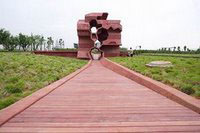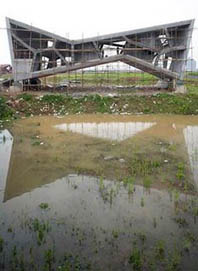Domus Magazine in Italy thought the Jinhua Architecture Park was so hip, that they published the park before anything was really complete in July 2006. “a+u” magazine in Tokyo published the suburban park of architectural follies in December 2006.
 Herzog & de Meuron
Herzog & de Meuron
Cataloguing a creative moment in architecture has rarely been done outside of temporary world fairs or biennales. The park is guaranteed to be “dated” within a few years. But dating may be a major technique to preserve difference in the future unified globe with its standard worldwide construction methods.
Face it. Local vernacular architecture is ending. Future subtleties of difference will be perceived by some, but to the space alien, the differences will be very decorative (within each economic group). These alien visitors will see global differences like we see differences between tribes and cultures in an isolated geography.
Current geographic and psychological role of historic places will be the only vacations from globalism. Due to politics, some cities such as Fez in Morocco or Havana in Cuba have this timefulness caused by isolation that might serve as a model to non-disneyland differences.
The curator of Jinhua, Chinese artist / architect Ai Wei Wei, has created place in which timefulness predominates. Not on purpose. The architectural follies will be dated in 15 years. The best have a permanent joyousness that can be felt through children as in these photographs of the HHF Architects pavilion.

The overall suburban park has placement in a longer time period of at least 200 years and growing – maybe. Or maybe the suburban park is at the end of its history. The folly or small building has a prominent role in the aesthetic history of suburbia. From the first mini-temple in the English garden to the Jefferson Memorial in Washington, DC, the principle remains intact: an isolated object in which the landscape has been manipulated to focus attention on the object. Techniques involve
1. an open vista, frequently with grass, in front of the object frames and leads the viewer’s eye;
2. a contrasting color, frequently white, against the dark green trees or blue sky and
3. a change in elevation from the viewer, frequently up, to attract the future visitors to look back and visually survey the land.
Of course it is China with its grand history of the garden. Framed objects in the landscape are significant. But somehow from the photos of Jinhua, the landscape is less dense and coordinated. Each folly is left alone with its land like the traditional suburb or modern sculpture garden.
It is strange how the suburban vision so desired. Even new Seattle sculpture garden could be seen as a contorted and desperate attempt to preserve the suburban vision as the urban world crushes around it. Get out the giant date stamper: 20th CENTURY. And thank you for it.
All photos by IWAN BAAN. Click Here for all the Photos.

Fernando Romero
Public Art, Public Space
